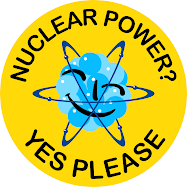
"Nuclear power stations are uninsurable so the insurer of last resort in all countries has to be the government. The government has to say we're going to underpin the uninsurable risk of the nuclear sector," he said.
He added that nuclear power stations worked on a much larger scale of economy.
"We're talking of thousands of megawatts of generation. It's a long-term investment and nobody really has effectively sorted out the long-term trailing costs of holding redundant nuclear stations for the next 300 years," he said.
So he is seeking bi-partisan political support (for long-term insurability), as well as other long-term assurances. I believe these represent the critical, relevant issue. Long term business security.
Next, Dr. Ziggy Switkowski predicts a decision on nuclear power in Australia by the end of the year in this Sky News report.
Lastly, a fairly generic story from UPI where John Howard and Werner Burkart of the IAEA promote nuclear power, but add no real substantive details (of 'how', 'when', or 'who' is to do 'what' etc.). I wouldn't really recommend it if it weren't so short.















I can never understand why people claim that nuclear power plants are uninsurable. Nuclear Power Plants world wide have proved to be much safer than the coal industry, the natural gas industry or the chemical industry, including accounting for the deaths and injuries sustained at Chernobyl (there were none at Three Mile Island). World wide, the electricity industry is often controlled by government and they usually don't insure, it's not that they can't they just don't. In the US, the Price Anderson Act effectively creates an insurance pool owned by the industry - more like a mutual insurance company.
ReplyDeleteIn terms of decommissioning, or holding a plant for 300 years, the US also provides an excellent model. Plants are required to establish sinking funds - separately held - and during the years of operation contribute funds to ensure that there is sufficient money set aside to decommission the site. Decommissioning is complete when the NRC releases the site for unrestricted use. Several plants have already been through the entire process. Most plants have more than enough funds set aside for decommissioning. Those that don't have well developed plans for providing those funds. There are several companies, e.g. Areva, Westinghouse and BNFL, that provide decommissioning services, it is an established industry.
One can hardly expect the gas or coal industries to be big fans of nuclear - a potential competitor. So it is unsurprising that the CEO of the Australia Gas Light company is fanning the flames of the scaremongers.
Hello Matthew and thanks for your comment.
ReplyDeleteIf you check descriptions of the Price-Anderson Act, you will see the industry funded insurance scheme accounts for the first US $10 Billion of any claim. The US Government is liable for any remainder - making it the insurer of last resort.
I agree completely with your comments on overall nuclear performance and risk. It seems to me to be more of a political issue than an 'actuarial' one. But it is a bone of contention with some anti-nuclear leaning politicians - preventing bi-partisan support of the industry which is inhibiting utility investments.
The comments of the AGL executive do hold water for me. Rarely do you find utilities with a single technology in their generation portfolio. Many 'nuclear' power companies are simply a nuclear subsidiary of a larger utility.
Simply put, these companies just want to generate money via the generation (and in some cases transmission and distribution) of energy. Sure, they will defend their current capital investments (gas, coal, etc.) as a source of ongoing revenue. However, with respect to future generation, I believe they will deploy the technologies that optimise (maximise) potential profit while minimising business risk. And today, in Australia this means more coal.